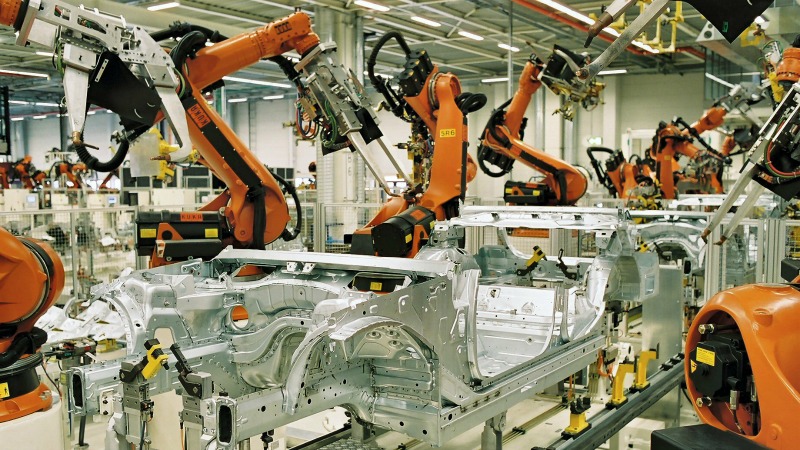www.aljazeerah.info
Opinion Editorials, August, 2016
Archives
Mission & Name
Conflict Terminology
Editorials
Gaza Holocaust
Gulf War
Isdood
Islam
News
News Photos
Opinion Editorials
US Foreign Policy (Dr. El-Najjar's Articles)
www.aljazeerah.info
China's Pivot to World Markets, Washington's Pivot to World Wars, and the Debacle of the Latin American Left
By James Petras

Al-Jazeerah, CCUN, August 22, 2016
 |
|
| Kuka Robotics |
While the US has spent trillions in the Middle East for wars on behalf of Israel, China has invested similar amounts in Germany for advanced technology, robotics and digital innovations.
Introduction
China and the United States are moving in polar opposite directions: Beijing is rapidly becoming the center of overseas investments in high tech industries, including robotics, nuclear energy and advanced machinery with collaboration from centers of technological excellence, like Germany.
In contrast, Washington is pursuing a predatory military pivot to the least productive regions with collaboration from its most barbaric allies, like Saudi Arabia.
China is advancing to global economic superiority by borrowing and innovating the most advance methods of production, while the US degrades and debases its past immense productive achievements to promote wars of destruction.
China’s growing prominence is the result of a cumulative process that advanced in a systematic way, combining step-by-step growth of productivity and innovation with sudden jumps up the ladder of cutting edge technology.
China’s Stages of Growth and Success
China has moved from a country, highly dependent on foreign investment in consumer industries for exports, to an economy, based on joint public-private investments in higher value exports.
China’s early growth was based on cheap labor, low taxes and few regulations on multi-national capital. Foreign capital and local billionaires stimulated growth, based on high rates of profit. As the economy grew, China’s economy shifted toward increasing its indigenous technological expertise and demanding greater ‘local content’ for manufactured goods.
By the beginning of the new millennium China was developing high-end industries, based on local patents and engineering skills, channeling a high percentage of investments into civilian infrastructure, transportation and education.
Massive apprenticeship programs created a skilled labor force that raised productive capacity. Massive enrollment in science, math, computer science and engineering universities provided a large influx of high-end innovators, many of whom had gained expertise in the advanced technology of overseas competitors.
China’s strategy has been based on the practice of borrowing, learning, upgrading and competing with the most advanced economics of Europe and the US.
By the end of the last decade of the 20th century, China was in a position to move overseas. The accumulation process provided China with the financial resources to capture dynamic overseas enterprises.
China was no longer confined to investing in overseas minerals and agriculture in Third World countries. China is looking to conquer high-end technological sectors in advanced economics.
By the second decade of the 21st century Chinese investors moved into Germany, Europe’s most advanced industrial giant. During the first 6 months of 2016 Chinese investors acquired 37 German companies, compared with 39 in all of 2015. China’s total investments in Germany for 2016 may double to over $22 billion dollars.
In 2016, China successfully bought out KOKA, Germany’s most innovative engineering company. China’s strategy is to gain superiority in the digital future of industry.
China is rapidly moving to automate its industries, with plans to double the robot density of the US by the year 2020.
Chinese and Austrian scientists successfully launched the first quantum-enabled satellite communication system which is reportedly ‘hack proof’, ensuring China’s communications security.
While China’s global investments proceed to dominate world markets, the US, England and Australia have been trying to impose investment barriers. By relying on phony ‘security threats’, Britain’s Prime Minister Theresa May blocked a multi-billion dollar Chinese investment-heavy nuclear plant (Hinckley Point C). The pretext was the spurious claim that China would use its stake to “engage in energy blackmail, threatening to turn off the power in the event of international crises”.
The US Committee on Foreign Investment has blocked several multi-billion dollar Chinese investments in high tech industries.
In August 2016 Australia blocked an $8 billion-dollar purchase of a controlling stake in its biggest electricity distribution network on specious claims of ‘national security’.
The Anglo-American and German empires are on the defensive. They increasingly cannot compete economically with China, even in defending their own innovative industries.
In large part this is the result of their failed policies. Western economic elite have increasingly relied on short-term speculation in finance, real estate and insurance, while neglecting their industrial base.
Led by the US, their reliance on military conquests (militaristic empire-building) absorb public resources, while China has directed its domestic resources toward innovative and advanced technology.
To counter China’s economic advance, the Obama regime has implemented a policy of building economic walls at home, trade restrictions abroad and military confrontation in the South China Seas – China’s strategic trade routes.
US officials have ratcheted up their restrictions on Chinese investments in high tech US enterprises including a $3.8 billion investment in Western Digital and Philips attempt to sell its lighting business. The US blocked ‘Chen China’s planned $44 billion takeover of Swiss chemical group ‘Syngenta’.
US officials are doing everything possible to stop innovative billion dollar deals that include China as a strategic partner.
Accompanying its domestic wall, the US has been mobilizing an overseas blockade of China via its Trans-Pacific-Partnership, which proposes to exclude Beijing from participating in the ‘free trade zone’ with a dozen North America, Latin American and Asian members. Nevertheless, not a single member-nation of the TPP has cut back its trade with China. On the contrary, they are increasing ties with China – an eloquent comment on Obama’s skill at ‘pivoting’.
While the ‘domestic economic wall’ has had some negative impacts on particular Chinese investors, Washington has failed to dent China’s exports to US markets. Washington’s failure to block China’s trade has been even more damaging to Washington’s effort to encircle China in Asia and Latin America, Oceana and Asia.
Australia, New Zealand, Peru, Chile, Taiwan, Cambodia and South Korea depend on Chinese markets far more than on the US to survive and grow.
While Germany, faced with China’s dynamic growth, has chosen to ‘partner’ and share, up-scale productive investments, Washington has opted to form military alliances to confront China.
The US bellicose military alliance with Japan has not intimidated China. Rather it has downgraded their domestic economies and economic influence in Asia.
Moreover, Washington’s “military pivot” has deepened and expanded China’s strategic links to Russia’s energy sources and military technology.
While the US spends hundreds of billions in military alliances with the backward Baltic client-regimes and the parasitical Middle Eastern states, (Saudi Arabia, Israel), China accumulates strategic expertise from its economic ties with Germany, resources from Russia and market shares among Washington’s ‘partners’ in Asia and Latin America.
There is no question that China, following the technological and productive path of Germany, will win out over the US’s economic isolationist and global militarist strategy.
If the US has failed to learn from the successful economic strategy of China, the same failure can explain the demise of the progressive regimes in Latin America.
China’s Success and the Latin American Retreat
After more than a decade of growth and stability, Latin America’s progressive regimes have retreated and declined. Why has China continued on the path of stability and growth while their Latin American partners retreated and suffered defeats?
Brazil, Argentina, Venezuela, Uruguay, Paraguay, Bolivia and Ecuador, for over a decade, served as Latin America’s center-left success story. Their economies grew, social spending increased, poverty and unemployment were reduced and worker incomes expanded.
Subsequently their economies went into crisis, social discontent grew and the center-left regimes fell.
In contrast to China, the Latin American center-left regimes did not diversify their economies: they remained heavily dependent on the commodity boom for growth and stability.
The Latin American elites borrowed and depended on foreign investment, and financial capital, while China engaged in public investments in industry, infrastructure, technology and education.
Latin American progressives joined with foreign capitalist and local speculators in non-productive real estate speculation and consumption, while China invested in innovative industries at home and abroad. While China consolidated political rulership, the Latin American progressives “allied” with strategic domestic and overseas multi-national adversaries to ‘share power’, which were, in fact, eagerly prepared to oust their “left” allies.
When the Latin commodity based economy collapsed, so did the political links with their elite partners. In contrast, China’s industries benefited from the lower global commodity prices, while Latin America’s left suffered. Faced with widespread corruption, China launched a major campaign purging over 200,000 officials. In Latin America, the Left ignored corrupt officials, allowing the opposition to exploit the scandals to oust center-left officials.
While Latin America imported machinery and parts from the West; China bought the entire Western companies producing the machines and their technology – and then implemented Chinese technological improvements.
China successfully outgrew the crisis, defeated its adversaries and proceeded to expand local consumption and stabilized rulership.
Latin America’s center-left suffered political defeats in Brazil, Argentina and Paraguay, lost elections in Venezuela and Bolivia and retreated in Uruguay.
Conclusion
China’s political economic model has outperformed the imperialist West and leftist Latin America. While the US has spent trillions in the Middle East for wars on behalf of Israel, China has invested similar amounts in Germany for advanced technology, robotics and digital innovations.
While President Obama and Secretary of State Hillary Clinton’s “pivot to Asia” has been largely a wasteful military strategy to encircle and intimidate China, Beijing’s “pivot to markets” has successfully enhanced its economic competitiveness. As a result, over the past decade, China’s growth rate is three times that of the US; and in the next decade China will double the US in ‘robotizing’ its productive economy.
The US ‘pivot to Asia’, with its heavy dependence on military threats and intimidation has cost billions of dollars in lost markets and investments. China’s ‘pivot to advanced technology’ demonstrates that the future lies in Asia not the West. China’s experience offers lessons for future Latin American leftist governments.
First and foremost, China emphasizes the necessity of balanced economic growth, over and above short-term benefits resulting from commodity booms and consumerist strategies.
Secondly, China demonstrates the importance of professional and worker technical education for technological innovation, over and above business school and non-productive ‘speculative’ education so heavily emphasized in the US.
Thirdly, China balances its social spending with investment in core productive activity; competitiveness and social services are combined.
China’s enhanced growth and social stability, its commitment to learning and surpassing advanced economies has important limitations, especially in the areas of social equality and popular power. Here China can learn from the experience of Latin America’s Left. The social gains under Venezuela’s President Chavez are worthy of study and emulation; the popular movements in Bolivia, Ecuador and Argentina, which ousted neo-liberals from power, could enhance efforts in China to overcome the business- state nexus of pillage and capital flight.
China, despite its socio-political and economic limitations, has successfully resisted US military pressures and even ‘turned the tables’ by advancing on the West.
In the final analysis, China’s model of growth and stability certainly offers an approach that is far superior to the recent debacle of the Latin American Left and the political chaos resulting from Washington’s quest for global military supremacy.
***Share the link of this article with your facebook friends
|
|
|
|
||
|
||||||


